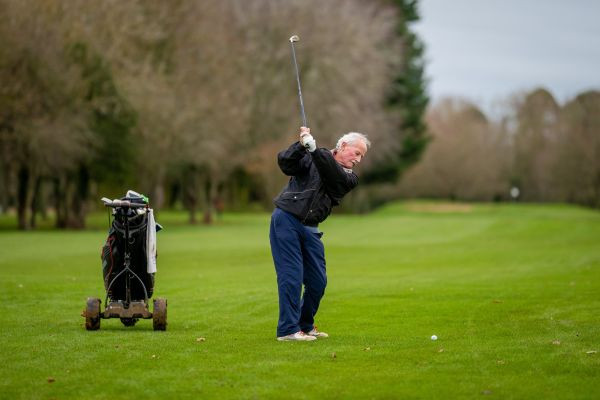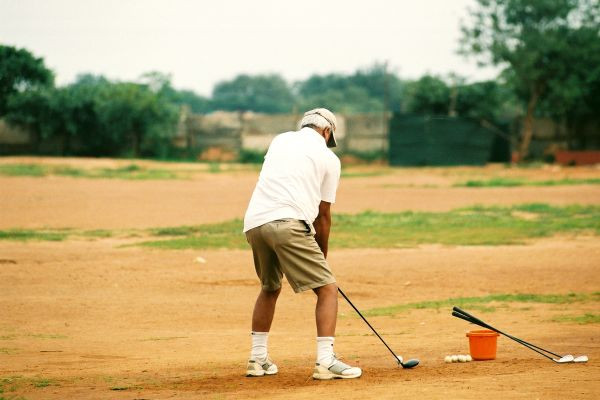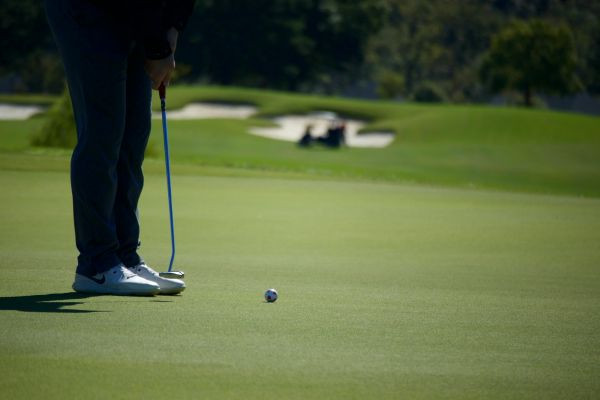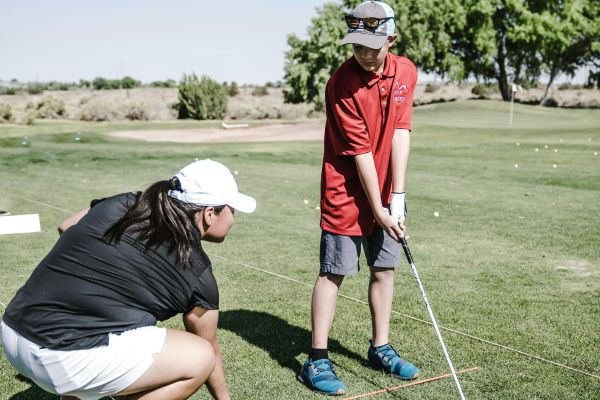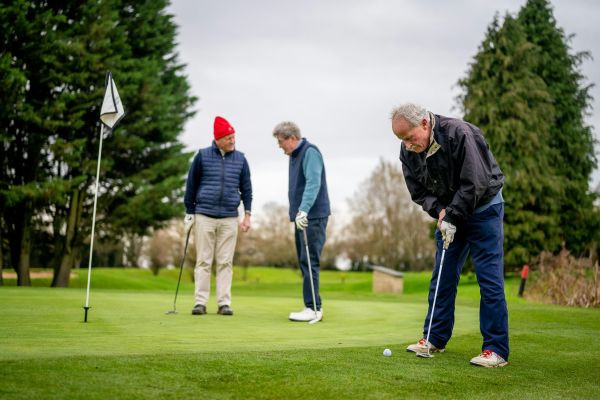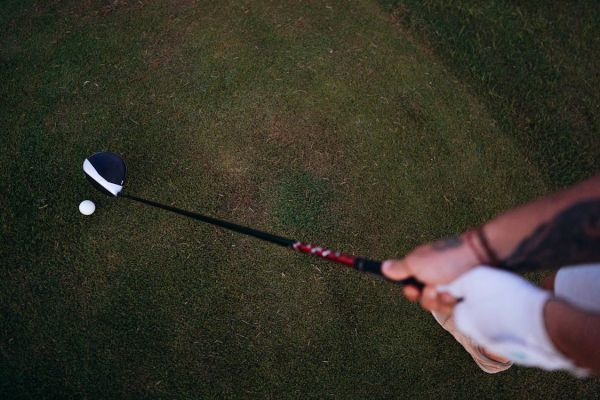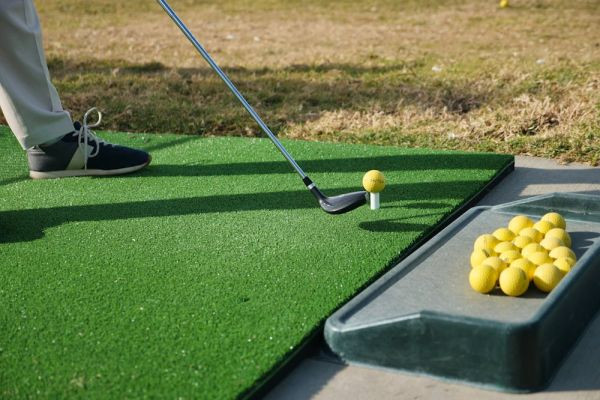How to Transform Your Golf Game with the No 1 Trick All Golfers Need To Learn
Golf isn't just a sport; it's an art form where every swing counts. A good golf swing is a symphony of coordinated movements each playing a crucial role in sending the ball soaring towards the green.

Golf isn't just a sport; it's an art form where every swing counts. A good golf swing is a symphony of coordinated movements each playing a crucial role in sending the ball soaring towards the green.
Often beginners are told that a golf swing is much like a baseball swing. While they share some principles — like power and timing — the two have distinct differences crucial for your understanding. In golf precision posture and the point of impact are paramount.
If you're looking to elevate your game, enhance your skills and enjoy the sweet satisfaction of a well-played round then you've come to the right place. In this article we will try to unlock the potential that lies in your clubs and within yourself. Whether you're a seasoned pro with years on the green or a newcomer eager to learn the trick, we're about to reveal promises to reshape your approach, refine your swing and rejuvenate your love for the game.
The No. 1 Trick Revealed
The Secret of Compression
The trick that can transform your game is understanding and mastering compression. But what exactly is compression? It's the moment of impact when your clubface presses against the ball momentarily flattening it. This action creates a tight controlled spin that propels the ball forward with precision and power. It's the sweet spot, the ideal collision between club and ball that every golfer strives to achieve consistently. It's about making that connection so sweet that you barely feel the ball off the clubface yet you watch it soar precisely where you intended. Achieving consistent compression is what separates amateurs from pros. It's not just about hitting the ball; it's about commanding its flight and dictating its landing.
But how do you achieve this elusive compression? It begins with your swing's foundation. The downswing particularly holds the key. A well-executed downswing brings the clubhead down on the ball with the right angle speed and position. As you swing, focus on keeping your wrists firm and your body aligned. Your lead wrist should be flat or slightly bowed and your trail wrist should maintain its hinge for as long as possible. This positioning helps create the downward strike essential for compression.
Moreover your body's rotation plays a crucial role. As you swing into the ball rotate your hips and shoulders to generate power. However ensure that this movement is synchronized with your arm and wrist action to maintain control and precision. The trick is to combine power with finesse allowing you to compress the ball without sacrificing accuracy or consistency.
Adjusting Your Swing
Customizing your swing is more than a one-size-fits-all solution. It's a personal journey to understanding the subtle nuances of your stance grip and the club's angle at impact. The stance sets the stage. It should be balanced and comfortable providing a solid base for your swing. Consider the width of your stance, the bend in your knees and the tilt of your spine. These elements should align to give you both stability and flexibility.
Your grip is your only connection to the club making it a critical aspect of your swing. The right grip can enhance your control and impact. Experiment with different grip strengths until you find one that offers both comfort and control. Remember a grip too tight can restrict movement while too loose can lead to inconsistency.
The club's angle at impact is perhaps the most critical factor in achieving compression. This is where the fine-tuning of your swing really comes into play. To attain that perfect angle focus on your hand and arm position during the swing. Your hands should lead the clubhead into the ball creating a forward shaft lean. This lean is crucial for striking down on the ball creating that desirable backspin.
But adjusting your swing isn't just a physical endeavor. It's also about aligning your mind. Confidence and focus are as vital as any physical aspect of your swing. Visualize the shot before you take it. Imagine the trajectory, the landing spot and the roll. This mental image can guide your body through the motion providing a blueprint for success.
In short transforming your golf game with the No. 1 trick of compression involves a symphony of movements and thoughts. It's about harmonizing the physical aspects of your swing with the mental fortitude required to execute consistently. With understanding and practice you'll find your swings becoming more powerful, your shots more precise and your game rising to new heights.
Implementing the Trick

Image by Pixabay
Pre-Swing Adjustments
Before you even begin your backswing the foundation for a successful shot is laid. Proper alignment and posture are crucial. Your body should be parallel to the target line with your feet, hips and shoulders all aligned. Imagine railroad tracks: your body is on one track and the ball is on the other. This alignment ensures accuracy and sets the stage for a powerful swing.
Posture is just as vital. Stand with a straight but not stiff back and a slight bend in the knees. Balance your weight evenly on the balls of your feet. This stance should feel both sturdy and dynamic ready to spring into action. Remember your posture dictates the arc of your swing so any slouching or rigidity can lead to mis-hits.
Visualizing the shot is a powerful tool. Close your eyes and imagine the ball's flight path from the moment it leaves the clubface to the spot where it lands on the green. Visualization not only prepares your mind but can also calm nerves and boost confidence.
Adjusting your grip is the final step. Ensure it's neither too tight nor too loose. A good grip allows for wrist hinges, a crucial element in generating power and control. As you grip the club, visualize holding a bird: firm enough that it can't fly away but gentle enough not to harm it.
During the Swing
The swing is where all your preparations come to life. Focus on maintaining a smooth fluid motion. Start with a controlled backswing keeping your movements synchronized. As you reach the top transition smoothly into the downswing. This is where power is generated through the combination of your body's rotation and the downward strike of the club.
Keep your eyes fixed on the ball. This not only aids in accuracy but also helps maintain head stability, a key factor in a consistent swing. Let your body's natural mechanics take over. Your hips, shoulders and arms should work in harmony creating a whip-like effect as you strike the ball.
Remember the swing is not just about power. It's about control and rhythm. Think of it as a dance with the ball where every movement is precise and purposeful.
Post-Swing Analysis
The swing doesn't end when the ball flies off the clubface. What follows is just as important. After each swing conduct a brief analysis. Ask yourself: Did the ball go where I intended? Did I maintain my posture? How did the grip feel? These questions can help identify what went right and what needs adjustment.
Pay attention to the ball's flight. A slice or hook can indicate issues with the swing path or clubface angle. The landing spot can tell you about the shot's power and accuracy. Use this information to make informed adjustments.
Consider recording your swings. Video analysis can offer insights that aren't apparent at the moment. It allows you to break down your swing frame by frame identifying areas for improvement.
Finally, don't overlook the mental aspect. Note how you felt during the swing. Were you tense, relaxed, confident or doubtful? Your mindset plays a significant role in your performance and understanding your emotional state can lead to a more focused and effective game.
Practice Techniques
Drills for Improvement
Practice is where the real transformation happens and specific drills are your roadmap to success. For instance the "No Takeaway Drill" helps you focus on the latter half of your swing ensuring a strong controlled impact. Start by setting your club halfway back then complete the swing. This helps you feel the correct motion through impact emphasizing the importance of the downswing and follow-through.
Another effective drill is the "Feet Together Drill" which improves balance and coordination. Hit balls with your feet close together; this forces your body to stabilize itself and improves your swing's efficiency. You'll learn to rely less on your body's movement and more on your arms and club leading to a smoother, more controlled swing.
Putting the "Gate Drill" is excellent for improving accuracy. Place two clubs on the ground forming a gate just wider than your putter. Practice putting through the gate to enhance your precision and control. This drill ensures your putter is moving straight back and straight through crucial for consistent putting.
Visualizing Success
Visualizing the swing goes beyond just imagining the ball going into the hole. It involves embedding that feeling deep in your mind connecting your practice sessions with gameplay. Before each shot take a moment to close your eyes and visualize every step of the process; from setting your stance to executing the swing, feeling the impact and seeing how the ball soars through the air. Imagine holding onto the grip sensing the ground beneath your feet and even feeling warmth from the sun on your back. The vividly you can picture it all in your mind's eye the more it will enhance your muscle memory.
Incorporate scenarios in your rehearsals as well. Envision hitting shots from challenging lies or dealing with difficult conditions. Picture yourself sinking putts with precision and confidence. By preparing for these situations you'll be better equipped to handle them when they arise on the course. This technique not only improves your performance but also cultivates resilience and boosts self assurance.
Common Mistakes and How to Avoid Them
Overcomplicating the Swing
Avoid getting caught up in overanalyzing and overcomplicating every aspect of your swing-- a pitfall for many golfers looking to improve their game. Becoming overwhelmed by technicalities simplifies your focus. Concentrate on one or two thoughts during each swing; perhaps keeping your head steady or maintaining a tempo throughout. Remember that a great swing is guided by flow, rather than excessive complexity.
Trust in the muscle memory you've developed through practice and allow your body to perform based on the training it has received. Remember, the ideal swing isn't necessarily the one that appears sophisticated but rather the one that works best for you.
Ignoring Body Mechanics
Every golfer's body is unique. It's crucial to understand how your own body moves in order to achieve a successful swing. Neglecting body mechanics, such as understanding how your hips rotate or how your weight shifts, can result in an ineffective swing and even potential injuries. Invest time into learning about how your body moves and reacts. It may be beneficial to seek lessons from a professional who can provide insights into your mechanics. Incorporating exercises and stretches that improve flexibility, strength and balance will contribute to a controlled swing.
Additionally it's important to be aware of your body's limitations and work within them. Forcing a swing or movement that feels unnatural for your body can cause harm than good. Pay attention to signals from your body; if something feels off or causes discomfort adjust your technique accordingly.
Advanced Tips for Seasoned Golfers
Fine-Tuning Your Technique
For golfers the pursuit of perfection is a journey that never truly ends.
Every time you step onto the golf course it's an opportunity to refine and perfect your technique. Pay attention to the details of your game. Focus on the pressure of your grip, the angle of your wrist, at the top of your swing and even small adjustments in your stance. While these may seem like changes they can greatly improve both accuracy and distance.
Consider the rhythm and timing of your swing. Do your backswing and downswing flow smoothly together? Sometimes even a slight pause at the top of your swing can add power and control to your shots. Experiment with rhythms until you find what works best for you.
Don't overlook the mental aspect well. As a player you likely have a mental game but there's always room for improvement. Work on maintaining your focus when under pressure. Practice visualizing shots as well as how you'll recover from less than ideal situations. This ability to bounce back can truly set apart good golfers from great ones.
Leveraging Technology
Taking advantage of technology is also crucial, for today's golfer. High speed cameras have the ability to capture the details of your swing allowing you to observe things that may go unnoticed by the naked eye. By analyzing your swing frame by frame you can pinpoint areas where you can improve or verify if any changes you've made are effective.
Swing analyzers and other wearable technologies can track aspects of your swing, such, as speed, angle and efficiency. This provides a wealth of data that can inform your practice routine. Additionally these tools offer feedback enabling you to make on the spot adjustments during practice sessions.
Taking things a step further are simulators and augmented reality setups that allow you to practice on courses under different conditions. These resources aren't just for off season training; they also provide a space for experimentation with changes in your swing without worrying about having a bad round.
Conclusion
Enhancing your golf game through mastering compression is a journey that requires understanding, practice and continuous improvement. Regardless of whether you're new to golf or an experienced player, improving your game demands dedication, patience and a willingness to constantly learn and adapt. Embrace the process and celebrate achievements, along the way and also learn from any setbacks encountered. By adopting a mindset and dedicating yourself you will experience progress and discover a greater sense of satisfaction in the sport of golf.
Frequently Asked Questions (FAQs)
What is the most important aspect of a golf swing?
The impact position is crucial — it determines the direction, trajectory and speed of the ball. Perfecting the moment of impact is essential for a successful swing.
How often should I practice to improve my game?
Regular consistent practice is more beneficial than sporadic lengthy sessions. Even 15-30 minutes of focused practice a few times a week can lead to improvements.
Can technology really help improve my swing?
Yes technology offers objective detailed feedback that can guide your practice and highlight areas of your swing that need attention.
Is there a difference between practicing on a range vs. an actual course?
Yes ranges are ideal for focusing on specific techniques and repeating shots while courses offer varied real-world conditions that test all aspects of your game.
How long does it take to see improvement in my golf game?
While individual experiences vary with consistent focused practice most golfers begin to see improvements within a few weeks.
What's the best way to learn from my mistakes?
Analyze what went wrong, adjust your technique or strategy accordingly and practice the corrected approach. Learning from mistakes is a valuable part of improving.
How can I maintain my golf skills during the off-season?
Indoor simulators putting mats and strength and flexibility training can help keep your skills sharp year-round. Also mental practice and visualization can maintain your game's mental aspect.













